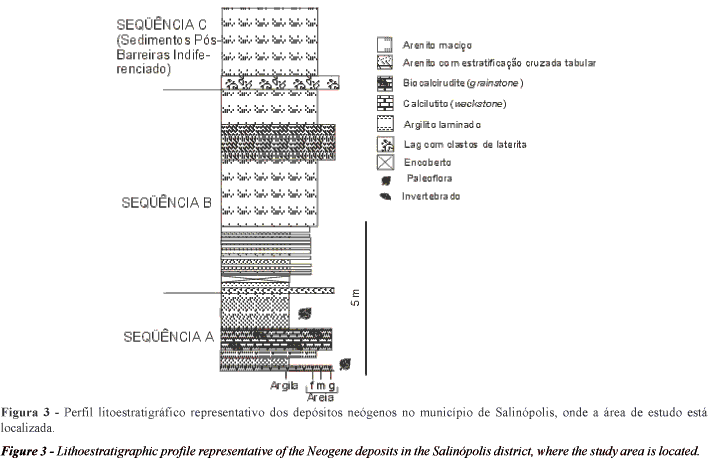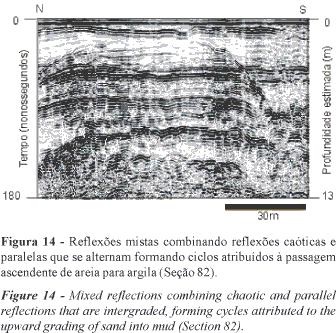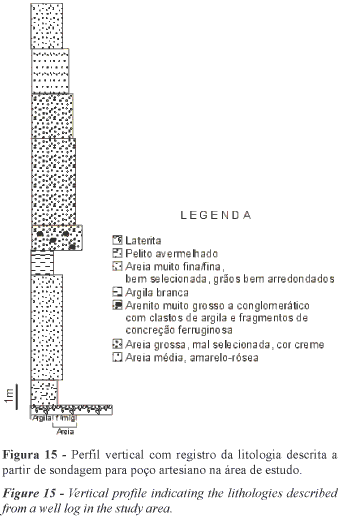Ground penetrating radar (GPR) is a geophysical method that consists in the emission of electromagnetic waves of high frequency (between 10-2500 Mhz). This equipment has been increasingly applied for mapping of physical properties and chemical compositions of rocks at shallow depth, as well as for stratigraphic and facies analysis. The application of this methodology in Brazil is still reduced to a few studies, mostly emphasizing soil stratigraphy and eolian paleoenvironments. However, previous studies undertaken in northern Brazil have demonstrated that, in combination with traditional studies using outcrop data, the GPR might be a powerful additional tool to help correlating sedimentary successions and reconstruct depositional environments throughout the Neogene in the Bragantina Zone. In this paper, we will document a pioneer investigation applying a SYR-2 GPR system (Geophysical Survey Systems Inc.) in the Praia do Atalaia area, Salinópolis, northern Brazil, which allowed us to characterize, for the first time, facies and stratigraphy of the deposits known informally as Pós-Barreiras Sediments (Pliocene and younger). The equipment was operated using a 200 Mhz monostatic antenna in continuous mode. The acquired sections were processed using the RADANWIN software in order to increase the reflection resolution and thus allow a refined interpretation of the sections. Based on this procedure, it was noticed that the studied sedimentary succession overlies unconformably the Miocene basement, represented by the Pirabas/Barreiras formations. Three stratigraphic units were also distinguished. The lowermost Unit 1 consists of an interval up to 6 m thick dominated by poorly-defined, low amplitude reflections, which intergrade with medium-scale, tangential oblique and hummocky reflections. This unit revealed to be discontinuous throughout the studied radar sections, occurring mainly where the Miocene basement is depressed. The middle Unit 2 is circa 9 m thick and mostly includes large-scale oblique reflections varying in style from parallel, tangential, sigmoidal to sigmoidal-complex. The two latter ones might reach up to 7 m thick. A strong, high amplitude and laterally continuous reflection marks the top of Unit 2, forming a bounding surface having local depressions of up to 40 m in relief. The uppermost Unit 3 corresponds to an interval ranging from 3.5 to 9 m thick, which is dominated by hummocky reflections, followed by medium-scale oblique, parallel to sub-parallel and cut and fill reflections. The GPR data allows the interpretation that the Pós-Barreiras Sediments were unconformably deposited over the Miocene deposits, as revealed by the mapping of an erosional bounding surface at the base of Unit 1. In addition, the analysis of internal reflection configurations and reflection geometries led us to propose that the Pós-Barreiras Sediments is more variable in terms of facies than previously thought, including eolian deposits (coastal dunes), as well as beach ridge, tidal flat, channel and mangrove deposits. Furthermore, the mapping of the three stratigraphic units described above is important to unravel the complexity of sedimentation versus erosion during the latest Neogene in northern Brazil. The conclusions obtained from the GPR data lead to suggest a drop in relative sea level after the end of the Miocene-lower Pliocene in the Bragantina Zone, which was followed by a transgression and deposition of Unit 1 along embayments and adjacent eolian dunes and/or beach ridges. Renewed phase of relative sea level drop took place, which led to erosion of the uppermost portions of Unit 1, forming a bounding surface that is locally cut by fluvial channel scouring. Large-scale eolian dunes laterally intergraded with tidal flat, filling the depressions formed by channel erosion during a subsequent transgressive phase. At least one more drop in relative sea level appears to have taken place in the study area, as revealed by the discontinuity surface between units 2 and 3, which is in turn mantled by modern sedimentation along mangroves, tidal channels and coastal dune environments.
Ground penetrating radar; Neogene; Bragantina Zone; Northern Brazil; Stratigraphy; Facies analysis




















